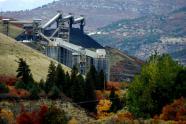Coal Generation in Retreat
Natural Gas Use to Soar

America is becoming less reliant on its long-time
mainstay, coal-fired electric power generation.
Total coal consumption in the electric power sector
this year is expected to reach 998.8 million tons,
according to a
U.S. Energy Information Administration report
this month.
In 2011, that figure will slip to 992.3 million
tons, the government predicts.
The drop in coal-burning for generation reflects the
steep decline in electricity demand faced by
utilities, a direct outgrowth of the recession.
Total electricity production last year fell 3.7
percent, the steepest one year decline in 72 years,
according to federal figures.
Utilities, faced with a sharp downturn in revenues
from power sales, are shelving plans for new coal
generation. A total for 43 coal plant projects
have been cancelled or deferred in the past two
years, according to the
Edison Electric Institute.
For planned future growth in demand, utilities are
banking on natural gas for generation. Natural gas
generation will represent 82 percent of the capacity
additional in 2013 - up from 42 percent in 2009,
according to the U.S. Energy Information
Administration. In comparison, coal will be just 10
percent of new generation capacity in 2013, down
from 18 percent in 2009.
Utility executives dependent on coal generation are
beginning to develop new strategies as a result of
concern about the contribution fossil fuels may make
to climate change.
Ameren, a St. Louis based utility, gets 85
percent of its electricity from coal generation.
Even so, Thomas Voss told
EnergyBiz, "We are accumulating
carbon, and I don't think we can indefinitely
accumulate carbon."
One strategy for addressing that concern is the
FutureGen research effort, which plans to develop a
near zero emissions coal-fired generation plant.
Kenneth K. Humphreys, the new
FutureGen chief executive officer, will describe
that initiative in detail at the
2011 EnergyBiz Leadership Forum.
Mark Crisson, president of the
American Public Power Association, said that if
all coal generators were converted to burn natural
gas, annual consumption of natural gas for power
generation would rise from current levels of about 7
trillion cubic feet to approximately 36 trillion
cubic feet.
Ample natural gas resources are available as a
result of recent development of new shale drilling
technology.
John Kelly,
Galvin Electricity Initiative deputy director,
said this month at
GridWeek, that today power generators use 25
percent of our natural gas capacity to generate
400,000 megawatts of power. There is plenty of room
for growth, with natural gas prices low and stable.
Still, natural gas supplies about 22 percent of our
power, and coal generation about half.
We are still dependent on coal-powered generation.
One week this month, 139,310 railroad cars were
loaded with coal at America's mines and transported
across the country to coal generating plants.
But one of the leading coal generation experts in
the nation said the future of coal depends on
whether significant industry uncertain about its
future can be addressed. Julio Friedmann, carbon
managment program leader at
Lawrence Livermore National Laboratory, said,
"that uncertainty breeds inaction."
Utility executives want to know if Congress will or
will not place a price on carbon emissions, and they
want to know if carbon sequestration will work and
be affordable. If carbon capture and sequestration
is not an option, Friedmann said, "We're on a fly
path to the end of coal. Period. Coal sunsets in 20
years."
Copyright © 1996-2010 by CyberTech, Inc. All rights reserved.
To subscribe or visit go to: http://www.energycentral.com
To subscribe or visit go to: http://www.energybiz.com